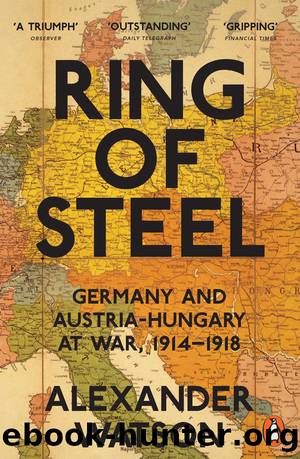Ring of Steel : Germany and Austria-hungary at War, 1914-1918 (9780141924199) by Watson Alexander

Author:Watson, Alexander [Watson, Alexander]
Language: eng
Format: epub
ISBN: 9780141924199
Publisher: Penguin Books Uk Ltd
Published: 2014-07-09T00:00:00+00:00
FORCED LABOUR
The Third OHL failed in 1916 to shift the basis of Germanyâs war effort from consent to control, but coercion nonetheless remained an important tool in economic mobilization. German workers might be intimidated into compliance by police, employers or the generals in charge of the countryâs home districts. However, the harshest and most blatant compulsion on Reich soil targeted enemy subjects. It is rarely remembered today just how dependent Germany was on foreign labour during the First World War. By 1918, around a seventh of its labour force, 2.5 million people in total, came from abroad. Most were, in some sense, forced labourers. Some 1.5 million military prisoners of war made up the majority and could legally be put to non-war-related tasks. However, there were also very many civilians: hundreds of thousands of Russian-subject Polish seasonal labourers were detained on large agricultural estates; tens of thousands of Belgian civilians were forcibly brought to Germany to labour in its industry; and even among the many foreigners who did sign an employment contract, compulsion had often played some part in their decision. Yet strikingly and perhaps counter-intuitively given the Nazisâ extensive use of slave labour in the Second World War, the primary lesson of the 1914â18 conflict was that forced labour did not work terribly well. The more violent the compulsion, the more miserable and recalcitrant workers became, and the less was achieved.25
Before the war, the booming German economy had attracted much immigrant labour. There had been half a million foreigners working in agriculture and a further 700,000 in industry. When hostilities broke out, 350,000 Russian-subject Polish seasonal workers were caught on the wrong side of the border. At first, the priority was to keep those of military age from joining the Tsarâs army. All others were to be retained only for the root-crop harvest and then expelled. However, by October 1914, it had dawned on the Prussian Secretaries of the Interior and Agriculture that these people would be crucial to the Reichâs farming and food supply in a long war, and they were consequently forbidden from returning home or leaving their jobs. Russian-subject Poles working in German industry were soon placed under similar restrictions. The home district generals accepted responsibility for enforcing discipline among these Poles. They were banned from striking or acting insubordinately and travel beyond their assigned locality was forbidden without prior permission from the general. To provide a semblance of legality for detaining people ineligible for military service, intense pressure was placed upon them to sign employment contracts âvoluntarilyâ.26 Two points should be noted. First, in detaining these people, the German state demonstrated right from the start of hostilities that it was prepared to act ruthlessly and against the spirit of international law to benefit its war effort. Second, its treatment of what were regarded as uncultured easterners was different from citizens of âcivilizedâ western states. British women, for example, were permitted to return home at the start of the war, while their 4,000 military-aged men were
Download
This site does not store any files on its server. We only index and link to content provided by other sites. Please contact the content providers to delete copyright contents if any and email us, we'll remove relevant links or contents immediately.
Magic and Divination in Early Islam by Emilie Savage-Smith;(1449)
Ambition and Desire: The Dangerous Life of Josephine Bonaparte by Kate Williams(1273)
Papillon by Henry Charrière(1260)
Bohemians, Bootleggers, Flappers, and Swells: The Best of Early Vanity Fair by Bohemians Bootleggers Flappers & Swells- The Best of Early Vanity Fair (epub)(1255)
Twelve Caesars by Mary Beard(1134)
Operation Vengeance: The Astonishing Aerial Ambush That Changed World War II by Dan Hampton(1109)
What Really Happened: The Death of Hitler by Robert J. Hutchinson(1066)
London in the Twentieth Century by Jerry White(1046)
Time of the Magicians by Wolfram Eilenberger(1026)
Twilight of the Gods by Ian W. Toll(1020)
The Japanese by Christopher Harding(1017)
Lenin: A Biography by Robert Service(979)
The Devil You Know by Charles M. Blow(929)
Freemasons for Dummies by Hodapp Christopher;(889)
A Social History of the Media by Peter Burke & Peter Burke(882)
Napolean Hill Collection by Napoleon Hill(860)
The Churchill Complex by Ian Buruma(855)
The Rise and Triumph of the Modern Self by Unknown(852)
Henry III by David Carpenter;(844)
